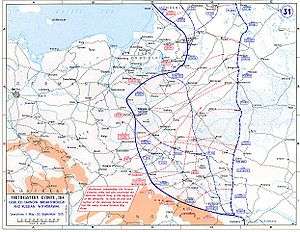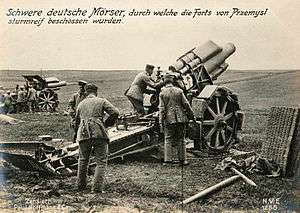Battle of Dunajetz
The Battles of Dunajetz occurred in May 1915 as part of the Gorlice–Tarnów Offensive during World War I. They were fought between the Russians (who were camped out along the line of the Dunajec river, the right tributary of the Vistula) and a force led by German General August von Mackensen to push the Russians out of Galicia and Vistula land (what is now Poland).
| Battle of Dunajetz | |||||||
|---|---|---|---|---|---|---|---|
| Part of Gorlice-Tarnów Offensive in the Eastern Front during World War I | |||||||
 Gorlice-Tarnów breakthrough and Russian withdrawal | |||||||
| |||||||
| Belligerents | |||||||
|
|
| ||||||
| Commanders and leaders | |||||||
|
|
| ||||||
| Units involved | |||||||
|
III Army VIII Army IX Army |
XI Army (Germany) IX Army (Germany) III Army (Austria-Hungary) | ||||||
| Strength | |||||||
| 1,000,000 | 2,000,000 | ||||||
| Casualties and losses | |||||||
| 100,000 men were taken as prisoners and "probably a similar number were killed"[3] | unknown | ||||||
Background

From August 1914 until early spring 1915, the Central powers prioritized war on the Western front to their Eastern front. This allowed Russian troops to steadily advance through Galicia, taking the Austrian territory, including the Hungarian fortress of Przemysl in March and seizing its weapons stores.[4] Progress was not easy, though and the Russian Imperial Army suffered heavy casualties. No matter how hard they were hit, they managed to recover so quickly that Prince von Bulow reportedly once said, "fighting the Russians [was] like pounding a pillow.".[5]
As a result of the Russian advance into Austria and chatter that Italy (which was neutral) was preparing to enter the war on the side of the Allies, the situation was seen as dire for the Austrian-Hungarian empire. The Central Powers reorganized their armies and Field Marshall von Hindenburg who believed that Russia "could be defeated in a single campaign, provided enough troops were at hand" [6] gave Mackensen command of the newly created German Eleventh Army with Colonel Hans von Seeckt as his Chief of Staff. He had two million men, 4,000 guns and operational control over the Austro-Hungarian Third and Fourth Armies stationed in Galicia.
Battle
The Russian Third Army, under the command of Nikolay Iudovich Ivanov was camped along the Dunajetz river, paused to regroup and resupply Mackensen, who had been ordered to break the Russian line attacked them on 1 May with an intense artillery bombardment that lasted four hours and used 70,000 shells.[7] This was followed up by an infantry assault. By noon of the first day, Mackensen captured the first lines of Russian soldiers. The next day, Prince Leopold of Bavaria's Ninth Army launched an attack with chlorine gas that had mixed results, with shifting winds carrying some of the gas back to unprotected German soldiers.
The Central forces broke a ten-mile gap in the Russian line and took the city of Tarnów.[8] They pressed the Imperial Army to chaotically retreat, with additional battles breaking out on 3 and 7 May. By 11 May the Russians began a full retreat to a prepared position along the San River. Wherever they could, they sought to engage the Central forces in delaying or exhaustive skirmishes. They two armies reached the San rivers on 14 May, thus ending the Battles of Dunajetz. The Central Powers had advanced about 80 miles.
By 11 May, it was clear that the Germans and Austro-Hungarians had numeric and tactical strength and so the Russians began a full retreat to a prepared position along the San river. Wherever they could, they sought to engage the Central forces in delaying or exhaustive skirmishes. They two armies reached the San rivers on 14 May, thus ending the Battles of Dunajetz, but continuing the successful Gorlice-Tarnow Offensive.
Parallel developments
While Mackensen directed his troops against the Russians along the Dunajetz, Hindenburg occupied Russian forces in northern Poland and Kurland, so they could not be sent as reinforcements. Also, due to Russian attention being drawn to their line further south, Hindenburg moved to attack Warsaw.
Outcome
The Central Powers had a number of military advantages going into this offensive. They were numerically and technologically superior. In addition, air superiority allowed them to carry out careful reconnaissance of Russian positions and well as drop bombs on the Russian trenches.[9]
The German focus, at this time, was to break Russian morale and take the sector of land between Gorlice and Tarnow. This would enable them to march on Przemyśl Fortress from the North and join the Austro-Hungarians approaching from the East and southeast. They certainly succeeded in doing so. By the end of May, the Russians had been pushed back to the Carpathian mountains.[10] However, the Battle of Dunajetz did not end in any conclusive way.
References
- p. 98: Hogg, Ian. Historical Dictionary of World War I. 2009. Accessed online via Google Books. ISBN 978-0810833722 OCLC 37418202
- p. 32: Hogg, Ian. Historical Dictionary of World War I. 2009. Accessed online via Google Books. ISBN 978-0810833722 OCLC 37418202
- p. 64: Hogg, Ian. Historical Dictionary of World War I. 2009. Accessed online via Google Books. ISBN 978-0810833722 OCLC 37418202
- p 678: Tucker, Spencer, and Priscilla Roberts, eds. World War I: The Definitive Encyclopedia and Document Collection. Vol. 2. N.p.: ABC-CLIO, 2014. Print. ISBN 978-1851099641. OCLC 864676778
- Burlingame, Edward Livermore; Bridges, Robert; Logan, Harlan (1915). "Scribner's Magazine".
- p. 116: Wren, Jack. The Great Battles of World War I. New York: Grosset & Dunlap, 1971. Print. OCLC 2779383. ISBN 978-0448020372
- p 512: Tucker, Spencer, and Priscilla Roberts, eds. World War I: The Definitive Encyclopedia and Document Collection. Vol. 2. N.p.: ABC-CLIO, 2014. Print. ISBN 978-1851099641 OCLC 864676778
- p. 116: Wren, Jack. The Great Battles of World War I. New York: Grosset & Dunlap, 1971. Print. OCLC 2779383 ISBN 9780448020372
- p 678: Tucker, Spencer, and Priscilla Roberts, eds. World War I: The Definitive Encyclopedia and Document Collection. Vol. 2. N.p.: ABC-CLIO, 2014. Print. ISBN 9781851099641 OCLC 864676778
- p. 116: Wren, Jack. The Great Battles of World War I. New York: Grosset & Dunlap, 1971. Print. OCLC 2779383 ISBN 978-0448020372
External links
![]()